WILHELM PRAGER
Amsterdam 1928
Unlike the previous entries in this Olympic series, this time I’m writing about two film made for the same event. Films that are shockingly different in quality, ambition, and execution, in spite of the fact they use almost entirely the same footage. These two wildly different approaches to documentary cinema provide one of the best examples I’ve ever seen of the power and importance of editing.
The Amsterdam Olympics were originally filmed by an Italian production studio run by Italy’s fascist dictator, Benito Mussolini. When the Dutch found out who was in charge, they were fairly understandably displeased. So displeased, in fact, they refused to screen the finished film, and demanded the IOC do something about it. Ultimately, a German studio was hired to take the existing footage and produce an entirely new film.
The difference between the two films is stark. The Italian production is four hours long, and unbelievably workmanlike. It’s still interesting to see for the historical details, but as a film it’s pretty awful. It’s boring. And more than just being boring, it’s also mostly incomprehensible. It’s hard to believe a four hour film would be lacking in details, but there you have it. We get races that cut off midway through. We see every preliminary heat, or throw, but with no information as to who won. We see events where we have no idea who anyone is, or what is actually happening. The entire thing is a mess.
The German re-cut, on the other hand, is really pretty good. It’s an hour shorter, but feels far more useful and memorable. It’s packed with funny intertitles, useful details, and innovative ways to show what’s actually happening. It was so great to see the same games, but feel like I had an idea of what actually happened. I learned a ton about the people and nations involved. I’ve never seen so stark and straightforward an example of the power of film editing. By cutting correctly, sequencing well, and using useful intertitles, a painful experience turned into something I enjoyed watching.
